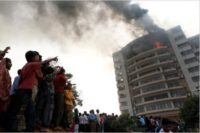
It happened again in Bangladesh in December 2010 - a fire in a garment factory killed 29 workers and hundreds were injured as they were suffocated, burned alive, trampled in stairwells, or leapt to their deaths from the 9th and 10th floors - because four of seven exit doors were locked.
On the eve of the 100th anniversary of the Triangle Shirt Waist fire in New York City that killed 146 in the same fashion, and after more than 15 years of “corporate social responsibility” (CSR) programs, women garment workers continue to die by the dozens making clothing for world famous retailers.
The December 2010 fire occurred at a ten-story factory run by the Ha-meem Group - one of Bangladesh’s largest garment manufactures which produces for a “who’s who” of global garment companies: Abercrombie & Fitch, Kenneth Cole, DKNY, Gap, Tommy Hilfiger, H&M, Izod, JC Penney, Calvin Klein, Kohl’s, Lee, North Face, OshKosh, Sears, Target, Timberland, Wrangler, and, of course, Wal-Mart.
Between 2006 and 2009, 414 workers died in 213 factory fires in Bangladesh, and more than 5,000 workers were injured. In 2010, besides the 29 dead at Ha-meem Group, 21 workers were killed and more than 50 injured in February at the Garib & Garib Sweater plant - again trapped behind locked exit doors on upper building floors.
Obvious hazards
The causes of these repeated factory fires are known to everyone involved: large quantities of poorly kept flammable materials, damaged and overloaded electrical systems, absent or completely inadequate fire suppression equipment, and non-existent or unimplemented emergency evacuation plans.
Add to this mix a near-total lack of enforcement by government safety agencies, poverty-stricken workers with few unions desperate for work, and the international brand retailers’ “iron triangle” of lowest possible prices, highest possible quality, and fastest possible delivery, and it is not surprising that killer fires occur all the time.
Factory fires are not the only imminent hazard: in April 2005, 64 workers died and 80 were injured (54 seriously) when the Spectrum Sweater factory building collapsed. The owners, also producing for major U.S. and European brands, had added five stories to the original four-story building – without building permits or proper engineering plans – and then stored heavy machinery on the “new” seventh floor before the building pancaked.
In the first six months of 2010 alone, the Bangladeshi Occupational Safety, Health and Environment Foundation counted 356 garment workers killed and 899 injured from all causes on the job.
$24 per month in wages
Moreover, Bangladesh’s garment workers are among the worst paid workers in the world. Between 2006 and November 2010, garment workers earned US$24 for a month of 10-hour days, five to six days a week. Last November the wage in the country’s “export processing zone” garment plants went up to a whopping US$43 a month - but significant numbers of contract manufacturers have refused to pay the new wage, leading to mass protests and police violence that has killed four workers and injured dozens more.
How in-depth are audits?
Brand retailers claim that they are addressing these problems through their highly touted CSR programs. But reliance on for-profit “third-party auditors” of the corporate codes of conduct (who are anxious to keep their international brand clients happy in the $37 million global CSR industry), and the inherent conflict between the brands’ CSR claims and their actual sourcing practices, has resulted in a spectacular failure in Bangladesh.
- U.S.-based Gap Inc. said it had inspected the Ha-meem Group plant (29 deaths) in the summer of 2010, several months before the December fire;
- At the Garib & Garib Sweater factory (21 deaths in the February 2010 fire), the plant had been repeatedly inspected by international brands (including Sweden’s H&M brand) and their third-party auditors, and it had even been “certified” by the garment industry’s in-house “Worldwide Responsible Accredited Production” (WRAP) program;
- The Spectrum factory (64 dead in the 2005 building collapse) had also been repeatedly audited by U.S. and European brands as well as their third-party monitors.
Near-zero enforcement
Despite fire after fire, scores of worker deaths, and hundreds of injuries, global clothing brands not only continue sourcing from death-trap Bangladeshi factories, but have increased purchase orders while paying everlower prices to contractors year after year. Between July and October 2010, garment exports from Bangladesh jumped almost 40 percent, rising to $6.8 billion. Despite their CSR codes, the rock-bottom wages and near-zero regulatory enforcement in Bangladesh are apparently too good for the brands to pass up.
Bangladesh now employs 3.4 million garment workers in 4,200 ready-made garment (RMG) factories that produced $12.6 billion in export earnings for the full year 2010, representing 78 percent of the country’s total export income. RMG exports have nearly doubled in the last five years, rising from $6.4 billion in 2005.
No voice for workers
In addition to an internally contradictory business model which pits “CSR values” against the “iron triangle” purchasing practices, the brands’ CSR programs have almost no participation by workers in their development and implementation. Without the active involvement of informed and empowered workers in conducting plant inspections and accident investigations, designing and evaluating corrective actions, and conducting peer training with co-workers, there will never be an end to the preventable deaths and labor rights abuses that no one - not even the brands - deny are endemic in global garment supply chains.
After the Garib & Garib fire in February 2010, three leading labor rights groups in Europe, Canada and the United States called on buyers sourcing from Bangladesh to implement “Health and Safety Action Points” (see "Information & resources"). After the Ha-meem fire in December, five international groups, backed by ten unions and labor rights groups in Bangladesh, demanded action by the brand retailers in the US and Europe.
Varying commitments of brand retailers
In January 2011, seven major garment corporations - Abercrombie & Fitch, Carter’s Inc., Gap Inc., JC Penney, Phillips-Van Heusen, Target and VF Corporation -publicly committed to a brand-financed, independent safety inspection program of Bangladesh garment factories.
The brands also committed to provide compensation to the survivors and heirs to those killed in the Ha-meem fire. Negotiations between the brands and Bangladeshi unions and labor rights groups are continuing to establish the “who and how” of the proposed program - the “devil is always in the details.”
Several major brands - such as Kohl’s and Wal- Mart - are conspicuous by their absence from this belated safety initiative, which could create a “competitive disadvantage” in protecting workers’ lives for the brands who are participating.
But the initiative could be the beginning of changing the brands’ schizophrenic business model and creating meaningful worker participation in factory safety programs. Without a real priority on worker protection and genuine worker participation, nothing will change on the factory floor, and workers will continue to die completely preventable deaths.
Or, as Kalpona Akter of the Bangladesh Center for Worker Solidarity pointed out after the Garib & Garib fire: “I would not say workers have died in the fires; I would say that they have been killed.”
Information & resources
- Sourcing from Bangladesh,” www. cleanclothes.org.
- December 2010 report from SweatFree Communities, “Enemies of the Nation or Human Rights Defenders? Fighting poverty wages in Bangladesh,” www.sweatfree.org.
- Clean Clothes Campaign (EU): www.cleanclothes.org.
- International Labor Rights Forum (US): www.laborrights.org.
- Maquila Solidarity Network (Canada): www.maquilasolidarity.org.
- Workers Rights Consortium (US): www.workersrights.org.

